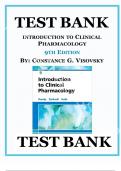TEST BANK
M
INTRODUCTION TO CLINICAL
ED
PHARMACOLOGY
9TH EDITION
C
BY: CONSTANCE G. VISOVSKY
O
N
N
O
IS
SE
U
R
TEST BANK
, Introduction to Clinical Pharmacology, 9th Edition Test Bank by Constance G. Visovsky
Contents:
Unit I: General Principles
Chapter 1. Pharmacology and the Nursing Process in LPN Practice
Chapter 2. Legal, Regulatory, and Ethical Aspects of Drug Administration
M
Chapter 3. Principles of Pharmacology
Unit II: Principle of Drug Administration
ED
Chapter 4. Drug Calculation: Preparing and Giving Drugs
Unit III: Drug Categories
Chapter 5. Anti-infective Drugs: Antibiotics, Antitubercular Drugs, Antifungals, Antiparasitics
Chapter 6. Antivirals and Antiretrovirals
C
Chapter 7. Drugs for Allergy and Respiratory Problems
Chapter 8. Drugs Affecting the Renal/Urinary and Cardiovascular Systems
O
Chapter 9. Drugs Affecting the Central Nervous System
Chapter 10. Drugs Affecting the Peripheral Nervous System
N
Chapter 11. Drugs for Pain Management
Chapter 12. Anti-inflammatory, Anti-arthritis, and Antigout Drugs
N
Chapter 13. Drugs for Gastrointestinal Problems
Chapter 14. Drugs Affecting the Hematologic System
O
Chapter 15. Immunomodulating Drugs
Chapter 16. Drugs Affecting the Endocrine System
IS
Chapter 17. Drugs for Diabetes Management
Chapter 18. Drugs for Ear and Eye Problems
SE
Chapter 19. Over-the-Counter Drugs, Herbal and Alternative Drugs, and Vitamins and Minerals
U
R
, Chapter 01: Pharmacology and the Nursing Process in LPN Practice
Visovsky: Introduction to Clinical Pharmacology, 9th Edition
MULTIPLE CHOICE
1. You are assessing the skin of a newly admitted patient and note a 2 inch area of redness at the
M
sacrum. Which type of data are you collecting with this information?
a. Objective data
b. Inspection
ED
c. Subjective data
d. Alternative therapy
ANS: A
Objective data are obtained by the healthcare provider during physical examination, or that are
measurable (i.e., laboratory results).
C
DIF: Cognitive Level: Applying REF: p. 3
2. Which part of the nursing process includes setting goals for the nursing care required when
O
giving drugs to a patient?
a. Assessment
b. Planning
N
c. Evaluation
d. Diagnosis
N
ANS: B
The nursing process consists of five major steps in this order: assessment, diagnosis, planning,
implementation, evaluation. It is in the planning step that the goals for nursing care related to
O
drugs are set based upon data collected.
DIF: Cognitive Level: Remembering REF: p. 4
IS
3. When would it be appropriate to withhold a drug instead of giving it to a patient?
a. When the order is written by hand
b. When any part of the drug order is unclear
c. When the drug improves the patient’s symptoms
SE
d. When the order contains both the generic and trade name of the drug
ANS: B
You must use good judgment in carrying out a drug order. If, in your judgment, the order is
unclear, or incorrect, it should be withheld (not given) until your concerns can be answered by
the patient’s healthcare provider.
U
DIF: Cognitive Level: Applying REF: p. 4
R
4. Which action would you take to ensure that an order for a drug is accurate?
a. Check the drug record with the Kardex file.
b. Compare the order with the drug history.
c. Compare the order to the patient’s reason for admission.
d. Check the drug record with the original healthcare provider’s order.
, ANS: D
Once the healthcare provider orders the drug, you must verify that the order is accurate. This
is done by checking the drug chart or drug record with the healthcare provider’s original order.
DIF: Cognitive Level: Remembering REF: p. 4
5. What do the nine “rights” of drug administration include?
a. Right patient, drug, dose, route, time, reason, documentation, response, and right to
M
refuse
b. Right drug, diagnosis, time, patient, route, drug history, documents, and right to
refuse
c. Right drug, amount, route, time, nurse, reason, route, diagnosis, and documentation
ED
d. Right dose, time, healthcare provider, patient, route, documentation, response, and
drug
ANS: A
There are nine “rights” of drug administration: you must identify the right patient, give the
right drug at the right dose, right route, right time, for the right reason, using the right
C
documentation to record that the dose has been given, monitor the patient for the right
response, and note that the patient has the right to refuse a drug.
O
DIF: Cognitive Level: Remembering REF: p. 5
6. Which action should you take to ensure that you are giving a drug to the right patient?
N
a. Verifying the drug record with the patient name on the chart
b. Verifying the patient’s room and bed number with the chart
c. Asking the patient to state his or her birthdate and Social Security number
N
d. Asking the patient to state their name and birthdate, and then checking the patients
identification bracelet
ANS: D
O
Before giving any drug, two forms of patient identifications should be used to identify the
correct patient. Each patient should be asked his or her name, and another form of
identification, such as birthdate; then you should check the patient’s identification bracelet.
IS
DIF: Cognitive Level: Applying REF: p. 5
7. Which category of drugs should be given exactly on schedule in order to maintain a consistent
SE
level of the drug in the body?
a. Steroids
b. Diuretics
c. Aspirin products
d. Anticoagulants
U
ANS: D
Certain drugs must be given at specific time interval (right time). Anticoagulants must be
given at the same time each day to maintain a therapeutic blood level in order to prevent blood
R
clots.
DIF: Cognitive Level: Applying REF: p. 7
8. Which nursing action is not appropriate when giving drugs to a patient?




